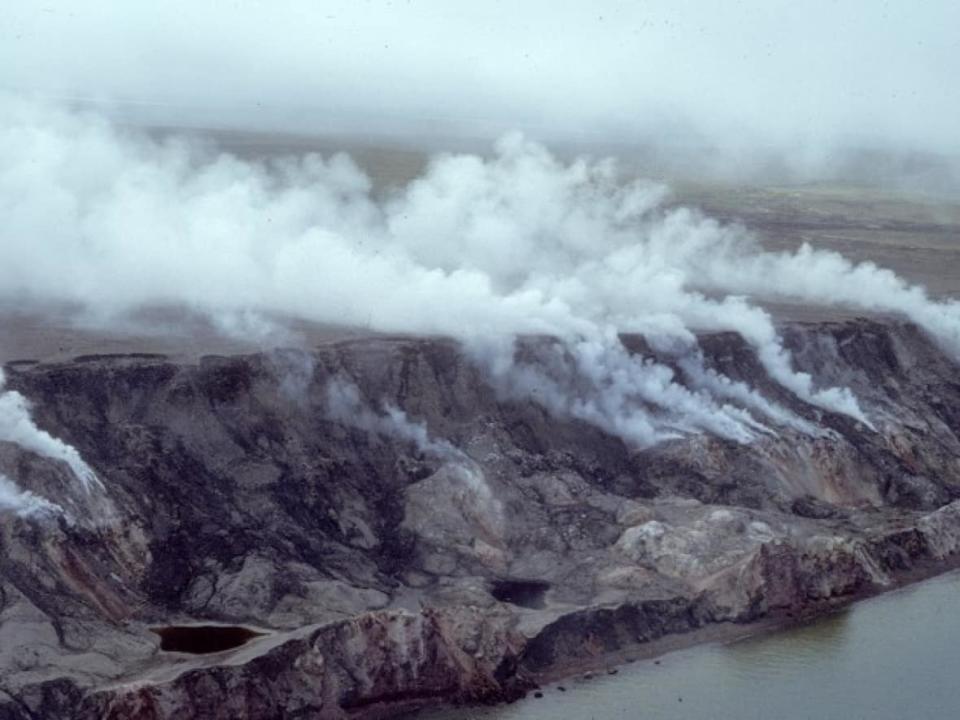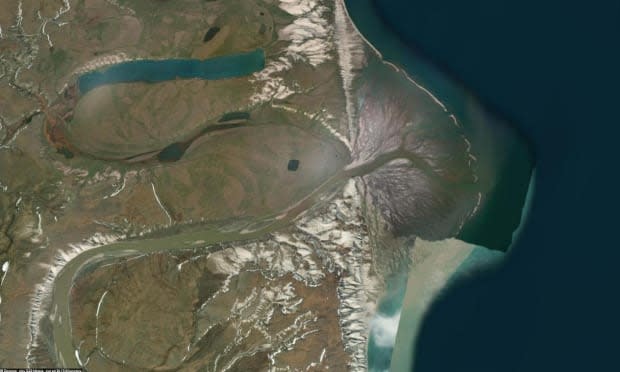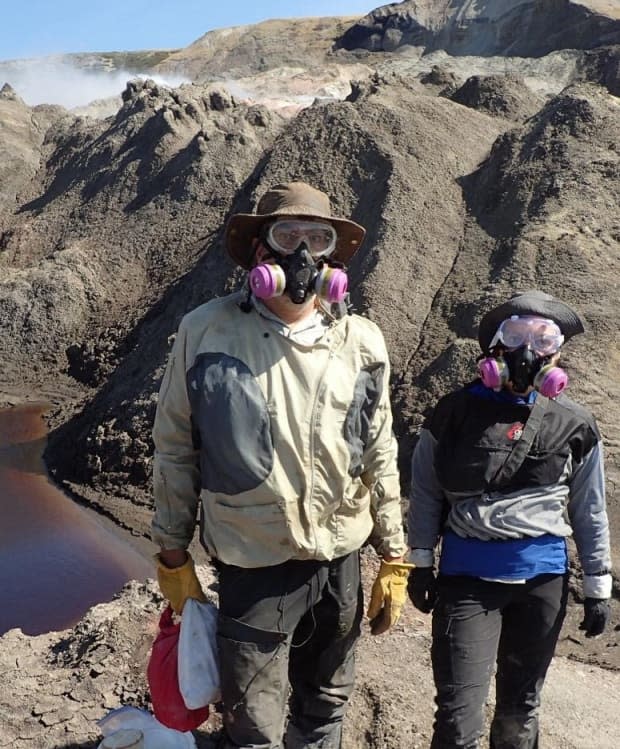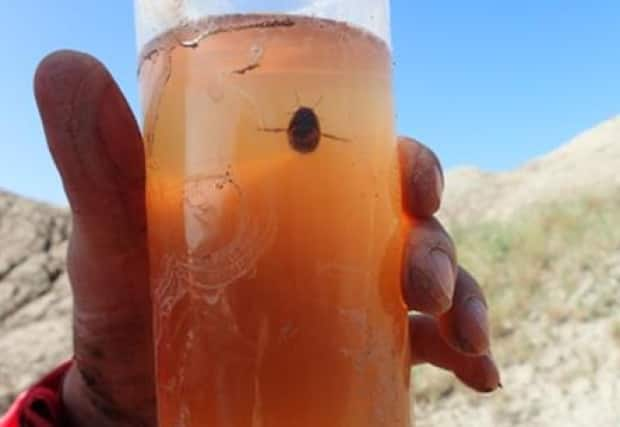What N.W.T.'s Smoking Hills could tell us about Mars

In a remote Arctic coastal area in the Northwest Territories, the smoldering earth is so hot that it will melt your boots. And there, researchers say they have found a mineral formation that could hold clues to understanding Mars and its history.
The Smoking Hills area between Tuktoyaktuk and Paulatuk, N.W.T., — known as Ingniryuat in Inuvialuit communities— is unusual because it is home to a mineral called jarosite, which is plentiful on the red planet but found in only a few places on Earth.

"You don't see burning rocks all over the world," said Steve Grasby, a scientist with the Geological Survey of Canada, who recently published research on the formations in the journal Chemical Geology.
The jarosite formations here are being studied to better understand the environment on Mars and how it evolved, and scientists think the timeline suggests the planet could have been more hospitable to life than previously thought. That's because the shale in Ingniryuat were deposited around 83 million years ago in oceans that were "teeming with life," similar to a modern ocean environment, said Grasby.
This suggests that even though jarosite is found in presumably acidic places on Mars, the planet may not have always been acidic — allowing more possibility of life — said Grasby.

"It could be something that happened millions of years later to form those layers, just like in the Smoking Hills," he said.
Future research in the area is planned for, once researchers consult with residents in Paulatuk and Tuktoyaktuk, the communities near the Smoking Hills, Grasby said.
'Everything says run'
The Smoking Hills area has long been the subject of oral histories, with stories of spirits hiding in the hills and minerals used to cure sick dogs.
Sitting at the mouth of the Horton River, where it meets the Beaufort Sea, the area is highly acidic and has jarosite layered in low-grade shales.

The ground is unbearably hot.
"I have these nice brand new hiking boots that were, like, expensive leather boots and they're just destroyed," said Grasby. "After two weeks of working there, I just had to throw them out."
Samples taken by the scientists were so acidic that they have a negative pH, and you need protective clothing and respirators with special filter cartridges to cut out the fumes.
The area is more acidic than a mine tailings drainage site, where jarosite is also found.
"It was difficult to even collect samples," he said.

The rocks and minerals were so hot they melted right through the jars and if spilled, would burn through clothing.
"Everything says run," says Grasby, laughing.
Vibrant colours
But the scientists aren't running. There is a lot to study — not just for space scientists, but also biologists and climate scientists.
Grasby said biologists want to understand how life persists such an inhospitable environment. Climate scientists want to understand the impact that the continually burning rock could have on our atmosphere, he said.
The burning of the shales accelerates as permafrost slumps on the Arctic coast, which further exposes the shale and causes it to burn.
The burning of the shale also produces highly acidic ponds and deposits metals like iron, lead, nickel, zinc and arsenic into pristine Arctic waters, said Grasby.
Biologists will want to learn more about what effect the release of these metals could have on marine environments.
The area surrounding the Smoking Hills is less hostile and even beautiful, with rolling open tundra. Depending on the wind direction, it could smell like fresh Arctic air or sulphur dioxide.
"In some areas where the shales have been burning … it turns it all into a red colour, so some very vibrant colours to the landscape," Grasby said.
The burning has even changed the course of a river, visible from satelite imagery hosted on Logan Earth.
Life in acidic ponds
Despite this environment — "probably the most acidic natural waters ever reported," according to Grasby — life in the Smoking Hills persists, which has biologists intrigued.
"In these ponds, there is basically one that's only like one kind of microbes that can handle it and that's pretty rare to have such low diversity," he said.

This life includes algal mats — "extremely simple life," says Grasby — that he and his colleagues at the University of Calgary are also studying.
The microbes that survive there are unique because some of the ways they have adapted to survive acidic environments also make it harder to withstand cold, he said.
On Earth, smoking shales appear in other high latitude places, such as Smoky River Alberta, northern Yukon and Greenland.
Researchers want to understand more about when the Ingniryuat began to burn, and how extensively the deposits could burn over time.
Ice sheets began melting around 10,000 to 15,000 years ago, but in the N.W.T. study area, it was at least 8,000 years ago that the glaciers receded enough to expose the rocks to oxygen.
Solving a puzzle
The scientific community has many diverging theories about rocks found on Mars and their Earthly counterparts.
Giovanni Baccolo, an Italian researcher at the University of Milano-Bicocca's environmental and earth sciences department, said that before the Canadian study, scientists hypothesized that jarosite was formed by exposing pyrite to oxygen.
"I've never heard about places like that with the production of such high temperatures because of the degradation of pyrite," he said, referring to the Smoking Hills area.

The Smoking Hills offer a rare chance for researchers to understand the environment on Mars, he said.
"You can't go there [Mars]," he said. "The only way to study it is to find a good analogue on Earth, and so it means you need to find an environment which is as similar as possible to the one you want to study."

